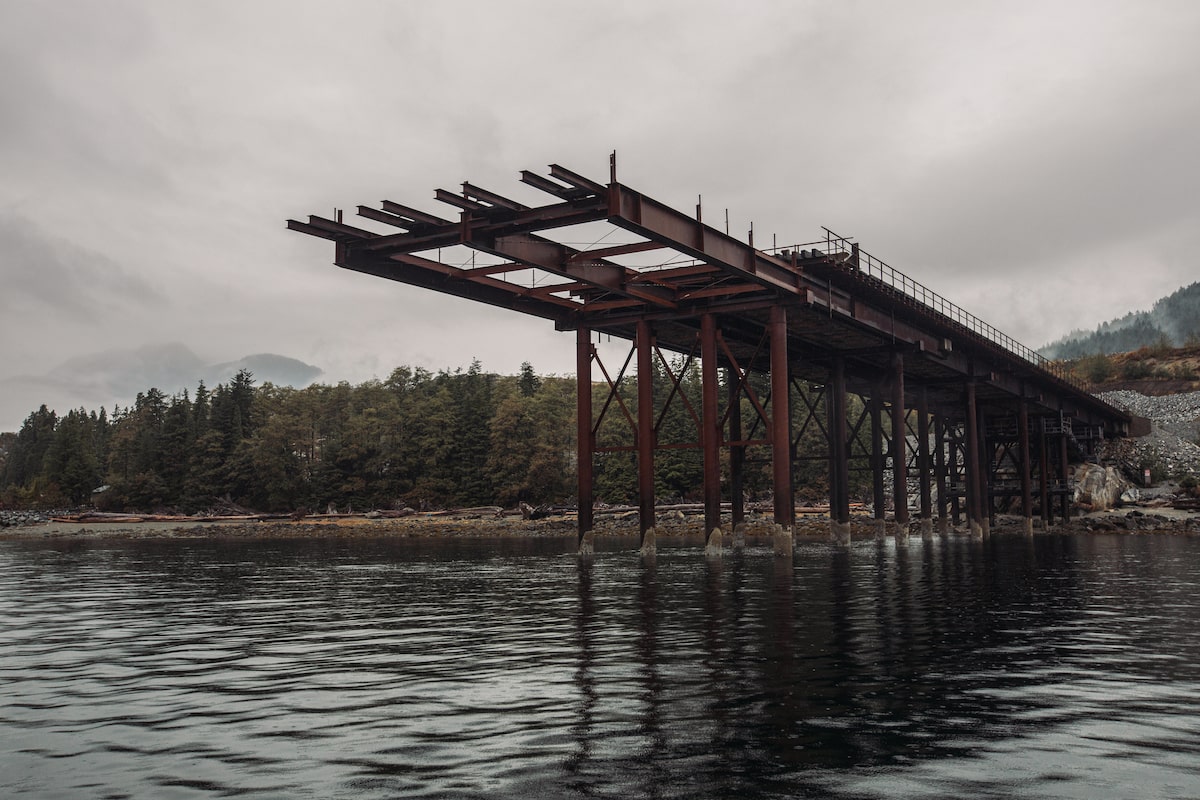A stalled project in Bish Cove in Kitimat, British Columbia, October, 2018. Haisla Nation’s Bish LNG GP Ltd. is set to take over the permits, licences and remaining land tenures for the abandoned Kitimat LNG project, which was scrapped by Chevron Corp. and Woodside Energy Group in 2021.Amber Bracken/The Globe and Mail
The Haisla Nation has reached a deal to acquire the assets of a cancelled project formerly envisaged to be one of the largest terminals for exporting liquefied natural gas from British Columbia.
The sellers, California-based Chevron Corp. and Australia’s Woodside Energy Group Ltd., finally scrapped the on-again, off-again project in 2021 after investing hundreds of millions of dollars. The co-owners, which each hold a 50-per-cent stake, had been unable to secure any buyers.
The agreement, revealed in a regulatory filing posted Oct. 30 and subject to approval from B.C.’s Environmental Assessment Office, would see the Haisla’s Bish LNG GP Ltd. take over the permits, licences and remaining land tenures for the abandoned project called Kitimat LNG.
Haisla officials have not announced any plans for the West Coast property at Bish Cove, located near Kitimat, B.C.
“Bish LNG GP Ltd. is in the process of purchasing the Kitimat LNG project and its environmental assessment certificate from the current holder,” the B.C. regulator said in a statement.
Haisla leaders have been long-time proponents of LNG development. Ellis Ross and Crystal Smith, who are former elected Haisla chief councillors, have maintained that the LNG industry poses far fewer environmental risks than crude oil, noting that Haisla members vehemently opposed the now-defunct Northern Gateway oil pipeline plans.
B.C. asks Ottawa to retain north coast tanker ban, blocking Alberta’s pipeline ambitions
Opinion: Does Canada need a new oil pipeline? Maybe. More LNG? Definitely
The Haisla own 50.1 per cent of Cedar LNG, while Calgary-based Pembina Pipeline Corp. holds 49.9 per cent. Woodfibre LNG is the only other LNG project under construction in B.C., despite energy companies unveiling more than 20 proposals in the province from 2011 to 2015 for exports to Asia.
Woodfibre LNG anticipates that it will complete construction at its industrial site near Squamish by late 2027, while Cedar expects to begin shipments from Kitimat by late 2028.
The US$4-billion Cedar project applied in September for regulatory permission to boost its future production capacity of LNG by 25 per cent to 3.75 million tonnes a year.
Pembina announced a 20-year agreement this week for Cedar to designate one million tonnes of LNG capacity annually to Malaysia’s state-owned Petronas.
Shell PLC-led LNG Canada became the country’s first export terminal for natural gas in liquid form when it started shipments to Asia from Kitimat in June.
The project’s first phase will have the capacity to export 14 million tonnes a year of LNG, after both “trains,” or processing units for supercooling natural gas, are fully up and running.
LNG Canada’s terminal started production from the second processing unit on Thursday, on the same day that the project’s 22nd export cargo departed. The co-owners are expected to make a final investment decision in 2026 on a Phase 2 expansion, which would double the plant’s total capacity.
Cedar and LNG Canada are located on the Haisla’s traditional territory in Kitimat.
In 2021, Chevron opted to stop funding for Kitimat LNG. Chevron and its partner Woodside sought to unload the joint venture.
Woodside bought its 50-per-cent stake in Kitimat LNG from Houston-based Apache Corp. in April, 2015. Back then, industry analysts viewed the Chevron-Woodside venture as being among the top three major LNG export proposals in B.C.
But the two companies suspended most construction work by late 2015 at the terminal site at Bish Cove after prices in Asia for LNG plunged.
Chevron was slated to be the project’s operator. “The vendors previously made a decision not to pursue the project,” according to a recent letter sent by Woodside to the B.C. environmental regulator and copied to Haisla elected chief councillor Maureen Nyce.
The Haisla’s Bish LNG GP said in a letter to the regulator that “it does not contemplate any significant changes to the project at this time.”
The abandoned Kitimat LNG joint venture had hoped to export up to 18 million tonnes a year.
Kitimat LNG’s proposed Pacific Trail Pipeline was designed to transport natural gas from the Summit Lake area in the B.C. Interior to Bish Cove.
Climate activists say B.C. needs to conduct new assessment for natural gas pipeline
Chevron and Woodside disclosed a total of US$2.32-billion in writedowns related to asset devaluations from their investments in the LNG venture on Haisla reserve land.
The David Suzuki Foundation said in a report released last month titled Running on Fumes that the LNG industry has a history of overpromising economic benefits and understating financial costs.
Site preparation at Bish Cove and other work, including constructing a new road along difficult terrain near Douglas Channel, turned out to be much more costly and complicated than originally anticipated.
In 2020, Chevron booked a non-cash, after-tax impairment charge of US$1.6-billion while Woodside wrote down US$720-million.
A B.C. project aiming to open in 2029, Nisga’a Nation-backed Ksi Lisims LNG, plans to have capacity for 12 million tonnes a year, which would make it the country’s second-largest export terminal for the fuel, after LNG Canada.
The Nisga’a, LNG Canada and Woodfibre welcomed this week’s federal budget.
But climate activists say Ottawa is propping up LNG, emphasizing that the focus should be on renewable energy instead of perpetuating the production of fossil fuels.
Activists warn that there are potent methane emissions, which contribute to climate change, during the production of natural gas through fracking.
